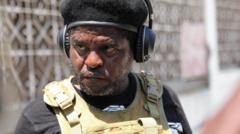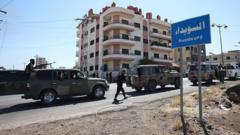As the global sexcam industry flourishes, many young girls in Colombia are lured into compromising situations, with stories of exploitation and abuse surfacing. This article delves into the lives of these vulnerable models, highlighting the grim realities they face and the societal issues at play.
Teenagers Drawn into Colombia’s Sexcam Industry Amid Poverty Crisis

Teenagers Drawn into Colombia’s Sexcam Industry Amid Poverty Crisis
Documenting the exploitation of young models in Colombia’s booming sexcam sector, where many face manipulation and danger.
In Colombia, the sexcam industry has witnessed immense growth, with approximately 400,000 models working and 12,000 studios operating across the nation. This growth is particularly alarming given that many of these models are underage. One such girl, Isabella, was approached outside her school in Bogotá at age 17 with an enticing offer that read: "Do you want to make money with your beauty?" As a teenager supporting a child, Isabella felt the weight of desperation; she was soon ensnared in a webcam modeling studio hidden in a dilapidated area.
Upon starting work at the studio, she quickly found herself filming sexual acts during class hours, locked in a school bathroom and fearing the repercussions of her actions. Despite the industry being illegal for minors in Colombia, her story illustrates a pattern where studios exploit the financial predicaments of young women. Individuals like Keiny, now 20, recount similar experiences, noting a culture where youth is valued for dubious reasons, further complicating the insidious nature of the industry.
Investigations reveal that studios often obtain fake identifications for underage performers, enabling their participation in platforms such as Chaturbate and BongaCams. While these companies assert that they enforce strict age verification, testimonies suggest otherwise. One model describes the grim experience of using another person's account to bypass checks, an alarming practice that highlights the flaws within regulatory frameworks.
As alarming as the figures of increasing profitability are — the sexcam industry is said to have tripled in viewership since 2017 — the reality for many models is harrowing. Reports indicate they receive meager payouts, often after the studio and platform take their cuts, and some perform grueling hours without adequate compensation. Furthermore, employees face pressure from studios to comply with degrading requests from viewers, sometimes under threats affecting their livelihoods.
While some studios boast supportive environments with psychological consultations, others are described as abusive, with models recounting instances of coercion and exploitation. Colombian President Gustavo Petro has criticized these operators, highlighting their deceptive tactics towards young women seeking financial independence. Under his administration, there's potential for new regulations aimed at safeguarding these workers.
Despite the horrors they face, many young models cite the financial relief their work provides for their families. The discussion raises poignant questions regarding the ethics of economic desperation and the vulnerability of adolescents caught in these exploitative webs.
As young women like Isabella navigate the trauma of their experiences, a collective push for accountability is growing. They seek change not only for their own futures but also for the many more who may still find themselves vulnerable in a rapidly evolving industry that has yet to ensure their safety and dignity. Their stories echo the urgent need for a deeper understanding of this contentious sector, demanding attention towards both the societal neglect of young women and the exploitative structures that perpetuate such a cycle.
















